Vietnam: The Helicopter War
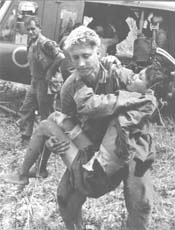
Aid For Fallen Foe - A US medic lifts a wounded Viet Cong prisoner in his arms to place him aboard a rescue helicopter. The prisoner has been hit by mortar fire during a guerilla action against US troops near the village of Plei Me in South Vietnam. He was flown to a nearby hospital for treatment.
Douglas Pike Photograph Collection [VA000500]
"So Others May Live:" Dustoff/Medevac
Soldiers in the Vietnam War often fought in remote areas of the jungle, regularly encountering bad weather and guerilla attacks. Vehicles faced landmines, ambushes, and awful roads. All of these factors caused problems for the military medical corps. How would they transport the wounded safely and quickly to hospitals for proper medical care? They decided to revisit an idea from the Korean War: the helicopter ambulance, which became known as a Dustoff.
A Dustoff crew consisted of four people: two pilots, a medic and a crew chief, with one pilot acting as the navigator, radio operator and secondary pilot. Early in the war, the crews began the practice of accepting missions no matter what the situation: unsecured landing zone, bad weather, overworked crew, no gunship support, and enemy fire.
In most cases a soldier would be in a hospital within 35 minutes of being wounded, which reduced the death rate of American soldiers in the Vietnam War to almost in half of that from World War II. Soldiers knew that the Dustoff crews would come for them no matter what, and because of that dedication they knew they had a better chance in Vietnam of surviving a wound than in any previous war.
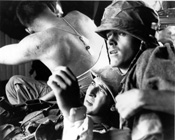
(022)The Face of War-- Corporal Larry R. Miklos, center, and an unidentified corpsman look in horror as an enemy machine gun fires at the medevac helicopter in which he is riding. Miklos an artillery forward observer, was wounded during an enemy ambush while on a search and destroy mission south of Da Nang on 1 September 1967.
Brigadier General Edwin H. Simmons Collection [VA020855]
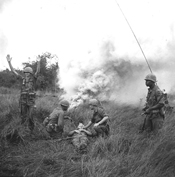
In a secured area on the outskirts of Saigon, medics and members of an Aviation Medical Evacuation Unit practice airlifting a soldier from the ground, up into a Huey using a cable hoist, and then fly to a local medical facility. Speed and technique were graded and all concerned received a thumbs-up. Photo by Robert C. Lafoon US Army Sp Photo Det, Pacific
Robert Lafoon Collection Department of the Army Special Photographic Office (DASPO) [VA029713]
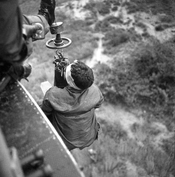
In a secured area on the outskirts of Saigon, medics and members of an Aviation Medical Evacuation Unit practice airlifting a soldier from the ground, up into a Huey using a cable hoist, and then fly to a local medical facility. Speed and technique were graded and all concerned received a thumbs-up. Photo by Robert C. Lafoon US Army Sp Photo Det, Pacific
Robert Lafoon Collection Department of the Army Special Photographic Office (DASPO) [VA029718]
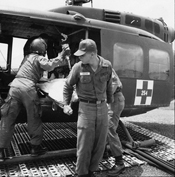
In a secured area on the outskirts of Saigon, medics and members of an Aviation Medical Evacuation Unit practice airlifting a soldier from the ground, up into a Huey using a cable hoist, and then fly to a local medical facility. Speed and technique were graded and all concerned received a thumbs-up. Photo by Robert C. Lafoon US Army Sp Photo Det, Pacific
Robert Lafoon Collection Department of the Army Special Photographic Office (DASPO) [VA029719]
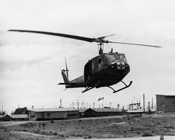
Medevac helicopter in for landing at 91st Evacuation Hospital Emergency Room.
James Evans Collection [VA042548]
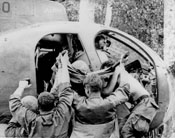
OH-6 helicopter. Members of 1st Battalion, 14th Infantry, 4th Infantry Division unload a helicopter for Operation Dust Off on Chu Pa Mountain in Vietnam. Photographer: SP5 Ryan
U.S. Army Aviation Museum Volunteer Archivists Collection [VA058626]
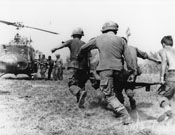
UH-1 helicopter, Little Bears - Soldiers rush with stretcher to waiting MEDEVAC
U.S. Army Aviation Museum Volunteer Archivists Collection [VA058810]
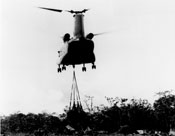
A CH-47 helicopter makes an aerial 'sling load' delivery of ammo. - Location: LZ Fatima, Vietnam. - Photographer: Robert Ellis
U.S. Army Aviation Museum Volunteer Archivists Collection [VA058840]
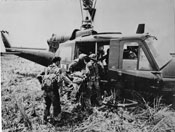
Soldiers loading wounded onto a UH-1 MEDEVAC helicopter in Vietnam.
U.S. Army Aviation Museum Volunteer Archivists Collection [VA059090]
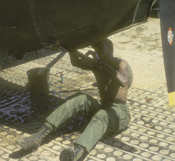
Crew Chief preparing aircraft for the next flight. They worked day and night to keep us in the air.
Roy Riddle Collection [VAS021933]
Bibliography
- Vietnam Archive Dustoff/Medevac Resources - Books
- OH0042, Pat King Collection, The Vietnam Center and Sam Johnson Vietnam Archive, Texas Tech University
- OH0249, Dan Cuneo Collection, The Vietnam Center and Sam Johnson Vietnam Archive, Texas Tech University
- VA000500, Douglas Pike Photograph Collection, The Vietnam Center and Sam Johnson Vietnam Archive, Texas Tech University.
- VA020855, Brigadier General Edwin H. Simmons Collection, The Vietnam Center and Sam Johnson Vietnam Archive, Texas Tech University.
- VA029713, Robert Lafoon Collection, The Vietnam Center and Sam Johnson Vietnam Archive, Texas Tech University.
- VA029718, Robert Lafoon Collection, The Vietnam Center and Sam Johnson Vietnam Archive, Texas Tech University.
- VA029719, Robert Lafoon Collection, The Vietnam Center and Sam Johnson Vietnam Archive, Texas Tech University.
- VA042548, James Evans Collection, The Vietnam Center and Sam Johnson Vietnam Archive, Texas Tech University.
- VA058626, U.S. Army Aviation Museum Volunteer Archivists Collection, The Vietnam Center and Sam Johnson Vietnam Archive, Texas Tech University.
- VA058810, U.S. Army Aviation Museum Volunteer Archivists Collection, The Vietnam Center and Sam Johnson Vietnam Archive, Texas Tech University.
- VA058840, U.S. Army Aviation Museum Volunteer Archivists Collection, The Vietnam Center and Sam Johnson Vietnam Archive, Texas Tech University.
- VA059090, U.S. Army Aviation Museum Volunteer Archivists Collection, The Vietnam Center and Sam Johnson Vietnam Archive, Texas Tech University.
- VAS021933, Roy Riddle Collection, The Vietnam Center and Sam Johnson Vietnam Archive, Texas Tech University.
Vietnam Center & Sam Johnson Vietnam Archive
-
Address
Texas Tech University, Box 41041, Lubbock, TX 79409 -
Phone
(806)742-9010 -
Email
vnca@ttu.edu

